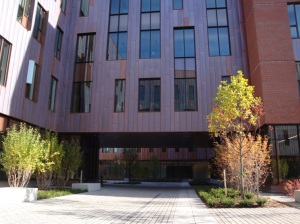by OEP intern Emily McInerney
 On March 25, 2008 President Hogan signed the American College and University Presidents Climate Commitment (ACUPCC). This pledge led way for UConn’s Climate Action Plan: a comprehensive outline that strategizes and maps out sustainability initiatives to help UConn reach its goal of carbon neutrality by 2050. Carbon neutrality is defined as proportional amounts of carbon released and carbon sequestered. This can be achieved through carbon offsets such as our Co-gen facility or something as simple as planting a tree. Realistically, however, carbon neutrality does not mean a zero carbon footprint. For UConn, the aim is to have the 2050 carbon emissions 86% below our 2007 levels. One of the very first initiatives implemented at UConn to lower GHG emissions was the adoption of our own Campus Sustainable Design Guidelines. These guidelines apply to both the construction of new buildings as well as the renovation of preexisting buildings.
On March 25, 2008 President Hogan signed the American College and University Presidents Climate Commitment (ACUPCC). This pledge led way for UConn’s Climate Action Plan: a comprehensive outline that strategizes and maps out sustainability initiatives to help UConn reach its goal of carbon neutrality by 2050. Carbon neutrality is defined as proportional amounts of carbon released and carbon sequestered. This can be achieved through carbon offsets such as our Co-gen facility or something as simple as planting a tree. Realistically, however, carbon neutrality does not mean a zero carbon footprint. For UConn, the aim is to have the 2050 carbon emissions 86% below our 2007 levels. One of the very first initiatives implemented at UConn to lower GHG emissions was the adoption of our own Campus Sustainable Design Guidelines. These guidelines apply to both the construction of new buildings as well as the renovation of preexisting buildings.
The Sustainable Design and Construction Policy requires a LEED (Leadership in Energy and Environmental Design) silver certification as a minimum performance standard for all projects that exceed $5 million. The U.S. Green Building Council developed LEED to act as an international green building certification system. LEED buildings offer savings in water and energy, reduce GHG emissions, improve air quality to promote health safety for occupants, and lower operating costs.

Most recently, the construction of two new buildings at UConn, Laurel and Oak Hall, have been completed that fulfill the LEED silver requirement. Oak Hall is set next to Homer Babbidge Library at the site of the former Co-op. Laurel is located where the Pharmacy building was originally constructed. These locations prevented the clearing of forests, wetlands, and other natural environments. There are several sustainable features that are important to note. From the outside, porous pavement reduces storm water runoff and flooding by providing storage and infiltration during storm events and a bio retention basin reduces harmful storm water runoff by collecting and holding storm water. The area is lined with native vegetation that provides habitat and food for local species. To reduce transportation CO2 emissions, biking is encouraged. There are 132 bicycle rack spaces available to facilitate bike transit.
Moving inside the building, the focus is on increased energy and water savings. The bathroom offers dual flush toilets and electric hand dryers to reduce paper waste. The combination of all water efficient features is anticipated to reduce water usage by 48%. The high performance windows both increase natural lighting which reduces energy costs and provide insulation through window glazing which reduce heating and cooling needs. Laurel is expected to have 16% energy savings and Oak is estimated to have 18% energy savings.
Visually speaking, LEED buildings are most notable for the recycled content and renewable materials that comprise their exterior paneling and interior walls and floors. Oak Hall uses bamboo for wall panels, recycled copper for the exterior siding and regional bricks. The bamboo is more sustainable than wood because it only take 3-5 years to harvest, the copper is made up of 80-95% recycled content, and the bricks are produced within 500 miles of campus. Approximately 75% of construction waste was diverted from landfills and reused or recycled.
Beyond sustainability, LEED buildings also have health benefits. Indoor environmental quality is improved through green cleaning products that are biodegradable, have low toxicity and low volatile organic compound content (VOC), and have reduced packaging. All plywood is formaldehyde-free and adhesives, sealants and paint have low or no VOC. Both Oak and Laurel are definite eye catchers. These buildings are not only environmentally friendly and cost effective but also aesthetically pleasing. It is something to appreciate that sustainability can be characterized as modern and hip. For those interested in seeing how these LEED buildings affect UConn’s GHG emissions, the Office of Environmental Policy is planning to upload energy and water saving dashboards online.
Here are some examples of the sustainability features in Oak and Laurel Halls:
Reblogged this on UConn EcoHouse.